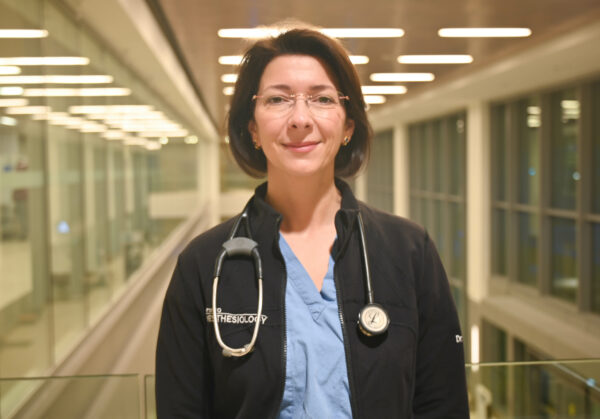Reflecting on Dr. Avramescu’s Teaching Experience
27
Dec
2023
In the past year, Humber River Health (Humber) had the privilege of hosting over 40 residents from prestigious institutions like the University of Toronto, McMaster University, and Queen’s University. Dr. Sinziana Avramescu, an Anaesthesiologist at Humber, teaches in the Department of Anesthesia and Pain Medicine at the University of Toronto and was recently recognized by the university for her overwhelmingly positive teaching evaluations.
Through achieving a perfect score in her evaluations, standing well above the average in comparison to other sites, Dr. Avramescu provides effective clinical teaching that stimulates learners to build knowledge and skills safely. Dr. Avramescu reflects on her teaching experience below.

What are qualities that define an excellent teacher in your field?
Different learners have unique learning needs, depending on their background, level of training, and ways of processing information and acquiring knowledge. Similarly, the dynamics vary significantly depending on whether one is teaching a large group of people in a conference setting, a small group of residents in a class, or a single trainee in the operating room. Recognizing and addressing these diverse learning needs is essential in anesthesia education to create effective and inclusive learning environments.
Excellent educators adapt their teaching style to the different needs of individual learners and to the various environments where teaching takes place. Excellent teachers are good listeners, flexible, enthusiastic, dedicated, and able to establish and maintain interactive professional relationships with their learners. In the operating room, qualities like professionalism, effective communication skills, empathy and adaptability are important attributes to be modelled and taught. As Anesthesiologists, our communication with patients is efficient, quick, and intense. However, we often have prolonged interactions with other members of the operating room team, such as surgeons, nurses, and auxiliary staff. Good communication and collaboration skills allow team members to share important updates, request assistance, and make decisions collectively. Timely communication is especially critical in emergencies or when unexpected challenges arise. Most importantly, excellent teachers are motivated to continuously enrich their own learning, remain up to date with the advances in their specialty, and are not afraid to also learn from their trainees.
How do you engage your students in active learning?
In Anesthesia, teaching often happens in the operating room, one-on-one with a learner. This allows us to better capture the attention of our trainees and provides us with the opportunity to better engage our students. An additional benefit of anesthesia teaching is that most of our trainees are adult learners, who are experienced and well-versed in their own learning requirements and styles. This allows them to actively guide the instructors, making their engagement particularly advantageous.
My approach begins with a Socratic questioning model, by asking a series of focused, open-ended questions that encourage reflection. In this way, I set the expectations for the day and help the students push the dialogue forward. I usually begin with a current medical case and actively engage the students to form meaningful associations to develop an approach and an anesthetic plan. I then challenge them to be prepared for the unexpected, encouraging them to reflect on the organization and implementation of a plan. I want the learners to develop a sense of ownership of the case from the beginning to the end. Finally, I constructively provide immediate and honest feedback after offering the learner the opportunity to reflect and provide their own opinion and feedback first.
I aim to build a trusting relationship with the learners, demonstrating care for their well-being and learning experience.
What steps do you take to create a supportive and inclusive learning environment?
The operating room can be a challenging learning environment as teaching occurs simultaneously with managing care for cases of varied complexity. Time is limited and the stakes are high. My approach is to set my expectations with the learners when we first work together. For me, patient safety and a respectful working environment are paramount. My view is that each member of the operating room team has invaluable knowledge, skills, and expertise that we must respect and use appropriately to best serve our patients. I support learners in performing level-appropriate procedures, provide formal teaching when time allows, and encourage all team members to voice their concerns, questions, and suggestions without fear of retribution. I strongly believe that cultivating a culture of mutual respect, professionalism, and valuing everyone’s input contributes to a psychologically safe operating room. This promotes a collaborative approach to patient care and reduces the likelihood of errors or oversights.
How do you incorporate technologies or innovations in your teaching?
Our learners are now the experts in the newest technologies in Anesthesia. They ask questions and provide suggestions on how we can use new discoveries in our clinical practice. Incorporating innovations in anesthesia teaching can enhance the learning experience, engage students, and keep the curriculum up to date with advancements in the field. I am often the one learning from our trainees about the newest technologies, such as using virtual and augmented reality to provide immersive learning experiences, using the best high-fidelity simulation technology to create realistic scenarios for hands-on practice, or using multimedia elements such as animations, virtual tours, and interactive diagrams in lectures or presentations. By embracing these strategies, anesthesia educators can create a dynamic and technologically enhanced learning environment that prepares students for the evolving landscape of healthcare and Anesthesia practice. Nonetheless, it is important to carefully and thoughtfully select the use of these technologies, ensuring that they enhance the learning environment for trainees instead of becoming distractions.
